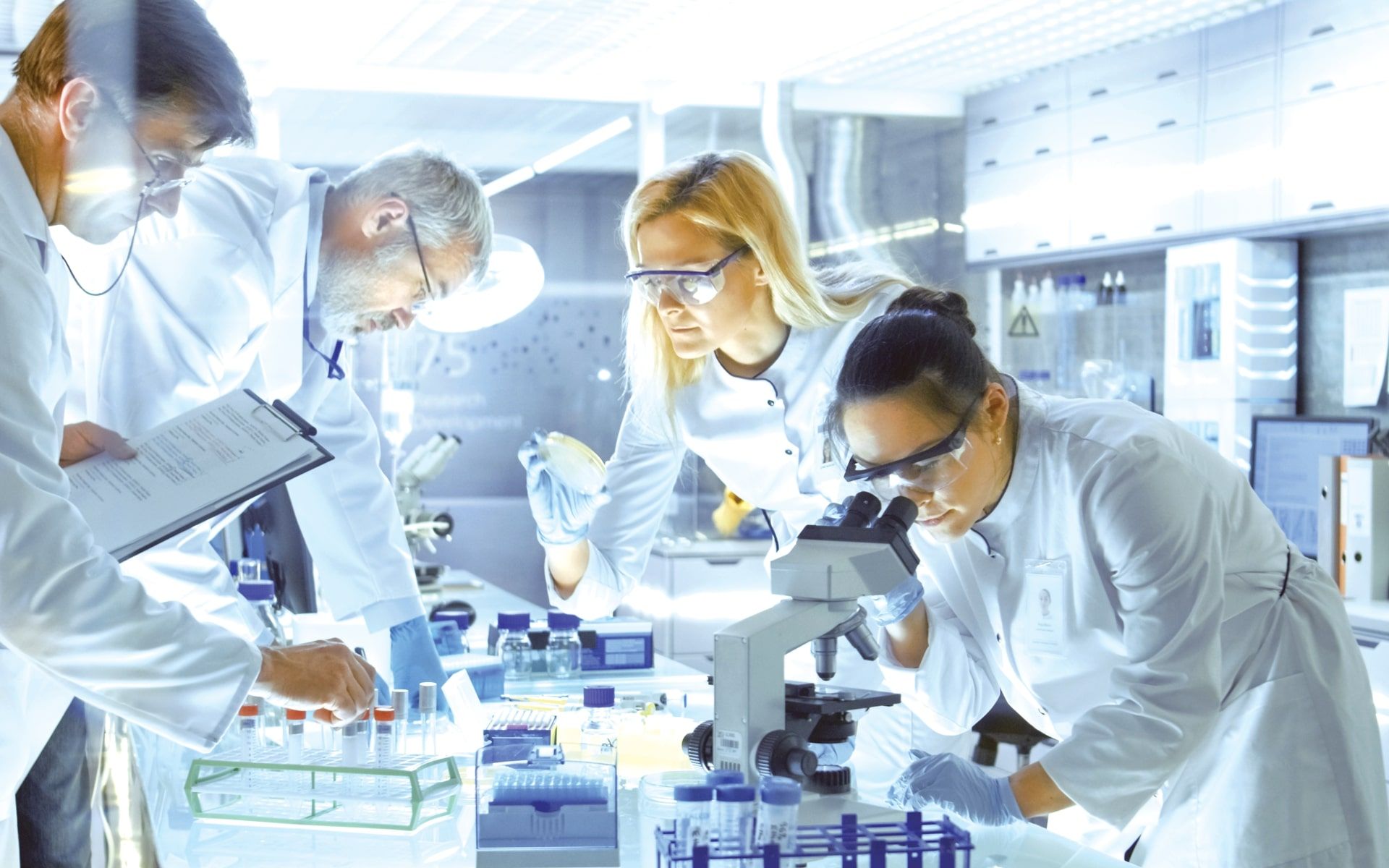Drug Development
- Clinical trials are a way to test new methods of diagnosing, treating, or preventing health conditions.
- After early testing, only a small number out of thousands of compounds look promising and call for further study.
- The entire process of developing a drug from its pre-clinical research stage to its final marketing phase can take approximately 12 to 18 years and often costs well over $1 billion.

In This Article
-
Clinical trials are a way to test new methods of diagnosing, treating, or preventing health conditions.
-
After early testing, only a small number out of thousands of compounds look promising and call for further study.
-
The entire process of developing a drug from its pre-clinical research stage to its final marketing phase can take approximately 12 to 18 years and often costs well over $1 billion
We all focused on one topic throughout 2020: Covid-19. No single day passed without news on the pandemic as we counted numbers of positive cases and the death toll while anticipating for a vaccine. In the meantime, we got more familiar with some of the medical processes, like phases, clinical trials, mutations, etc. for all this had to deal with the most precious gift we are given: life.
In our last issue, we touched upon the history of pharmacology and how modern-day drugs are made in an article titled “Pharmacology: The Journey of a Chemical Compound into a Drug.” Now, we will explore the multiple, lengthy phases of clinical trials that drugs must undergo and why they are imperative in order for new medicines to get approved for the marketplace.
Clinical trials are a way to test new methods of diagnosing, treating, or preventing health conditions. The goal is to determine whether a substance is both safe and effective. A clinical trial is only done when there is strong reason to believe that a new test or treatment may improve the care of patients.
A variety of treatment methods such as medications, medication combinations, new uses for existing medications, and medical devices are evaluated through clinical trials. In the United States, all new treatments must go through these trials before being approved for public sale by the Food and Drug Administration (FDA).
At the discovery and development stages, thousands of compounds may be potential candidates for development into a “drug”. After early testing, however, only a small number of compounds look promising and call for further study. The entire process of developing a drug from its pre-clinical research stage to its final marketing phase can take approximately 12 to 18 years and often costs well over $1 billion [3, 4].
Clinical trials show us what works and what does not in the realm of healthcare and are designed to answer some important questions such as:
- Does the new treatment work in people? If it does, how effective is it?
- Is it better than currently used treatments?
- If it is not better, is it just as good and cause fewer side effects?
- Does it work in some people who do not benefit from current treatments?
- Is the new treatment relatively safe? There is virtually no treatment or procedure that is without risk, but do the benefits of the new treatment outweigh the risks?
Answering these questions, while giving as few people as possible an unknown treatment, often requires several clinical trials in different phases. Each phase is designed to answer certain questions while keeping trial participants as safe as possible.
Preclinical phase
Before clinical trials can begin in humans, tests and treatments are assessed in pre-clinical research, which can involve extensive laboratory research over several years of testing on animals and human cells. This research may aim to learn the chemical compound of a drug [1]. If the initial laboratory research is successful, researchers send the data to health authorities for approval in order to begin research and testing on humans.
Once pre-clinical research results are approved, human testing of experimental drugs can begin and is typically conducted in four phases that are denoted by Roman numerals (Phase I, II, III and IV). Each phase is considered a separate trial and, after completion of a phase over many years, researchers are required to submit their data to, and then wait for approval from their local health agency (the FDA in the US) before continuing onto the next phase. If the drug successfully passes through Phases I, II, and III then it will usually be approved by the national regulatory authority for use in the general population. Phase IV trials are “post-marketing” or “surveillance” studies that are conducted to monitor how safe the product is over several years [2].
Phase I
This is the first clinical phase that involves humans. Phase I trials most often include healthy volunteers, however there are some circumstances when clinical patients are used, such as patients who have terminal cancer or HIV. These treatments possess a much higher risk for healthy individuals and could cause to become ill and contract serious adverse side effects.
In a Phase I clinical trial, doctors collect information on:
- The dose or treatment
- When it should be taken, and how often
- Any side effects or complications
- How the treatment affects patients and their preexisting conditions
One of the primary goals of Phase I studies is to find the highest dose of a new treatment that can be given safely without causing severe side effects. Although the treatment has been tested in laboratory and most likely been used in animal studies, the side effects in people cannot be known for sure. During Phase I of a clinical trial, researchers spend several months to evaluate safety, side effects, optimal dosage amounts, and formulation method for the drug on about 20 to 80 people who have no underlying health conditions.
In addition to evaluating safety and ideal dosage, specialists also look at the best way to administer the drug such as orally, intravenously, or topically. These trials are often conducted in a clinical trial clinic where the subject can be observed by full-time staff. Safety always remains the foremost concern in Phase I. The research team keeps a close eye on the people and watches for any severe side effects.
Researchers start by giving very low doses of the drug to a few patients while higher doses are given to other patients until side effects become too severe or desired effects are seen. The drug may help patients, but Phase I trials are to test a drug’s safety. If a drug is found to be safe enough, it can be tested in a Phase II clinical trial. According to the FDA, approximately 70 percent of medications move on to Phase II.
Phase 2
Phase II of a clinical trial usually involves anywhere from 50 to several hundred who are living with the condition that the new medication is meant to treat. They are usually given the same dose that was found to be safe in the previous phase. Investigators monitor participants for several months, or years, to see how effective the medication is and to gather more information about any side effects it might cause.
Most phase II studies are randomized trials where one group of patients receives the experimental drug, while a second "control" group receives a standard treatment or placebo. These studies are mostly "blinded" which means that neither the patients nor the researchers know who has received the experimental drug in order to avoid from bias. Doctors use a computer program to randomly sort volunteers into these two separate groups. Each volunteer has an equal chance of ending up in any of the groups and are randomly put in any group.
This allows investigators to provide the pharmaceutical company and the health authority with comparative information about the relative safety and effectiveness of the new drug. When the development process for a new drug fails, this usually occurs during Phase II trials when the drug is discovered to not to work as planned or to have toxic effects. The FDA estimates that roughly one-third of experimental drugs successfully complete both Phase I and Phase II studies.
Phase II clinical programs historically have experienced the lowest success rate of the four development phases. In 2010, the percentage of Phase II trials that proceeded to Phase III was 18% [5] and only 31% of developmental candidates advanced from Phase II to Phase III in a large study of clinical trials conducted during the period of 2006 – 2015 [6].
Phase III
Phase III of a clinical trial usually involves up to 3,000 participants who have the condition that the new medication is meant to treat. These participants must include men, women, and people of different ages and ethnic groups in many places across the country (or even around the world) at the same time. This helps doctors learn how treatment works in different people with different genetic backgrounds, races, and ethnicity. These studies tend to last longer – up to several years – than Phase I and II studies.
One of the additional purposes of Phase III is to evaluate how the new medication works in comparison to existing medications for the same condition. To move forward with the trial, investigators need to demonstrate that the medication is at least as safe and effective as existing treatment options. Due to the larger number of participants and longer duration of Phase III, rare and long-term side effects are more likely to show up during this phase.
There can be more than two treatment groups in Phase III trials. The control group may receive the current standard-of-care treatment for their illness while other groups receive the new treatment on trial. Phase III trials are usually double blinded to eliminate bias when interpreting results.
Placebos may be used in some Phase III studies, but they are never used alone if there is a treatment available that works. Sometimes, a patient who is randomly assigned to the placebo for part of the study will at some point be offered the standard treatment as well. As with other trials, patients in Phase III clinical trials are watched closely for side effects, and treatment is stopped if they become too hard to manage.
Every patient in a Phase III study is watched closely, and the study will be stopped early if the side effects of the new drug are too severe or if one group has significantly better results. Phase III clinical trials are often needed before the FDA will approve the use of a new drug for the general public. If researchers demonstrate that the medication is at least as safe and effective as others already on the market, then the FDA will usually approve the medication.
In the United States, when Phase III clinical trials (or sometimes Phase II trials) show a new drug is more effective or safer than the current treatment, a new drug application (NDA) is submitted to the FDA for approval. The FDA reviews the results from the clinical trials and other relevant information.
Based upon the review, the FDA then decides whether to approve the treatment for use in patients with the illness the drug was tested on. If approved, the new treatment often becomes a standard of care and newer drugs may be tested against it before they can be approved. If the FDA feels that more evidence is needed to show that the new treatment's benefits outweigh its risks, it may ask for more information or even require that more studies be done. Once Phase III is complete, a pharmaceutical company can request FDA approval to begin marketing the drug. Roughly 25 to 30 percent of medications move on to Phase IV.
Phase IV
Phase IV trials test new drugs that are approved by health authorities and often are called Post Marketing Surveillance Trials. The drugs are available for doctors to prescribe to patients, but Phase IV studies might still be needed to answer important questions. In previous clinical phases the drug may not have been tested for interactions with other drugs, or on certain population groups, such as pregnant women, who are unlikely to subject themselves to trials. This phase involves thousands of participants and can last for many years. Investigators use this phase to get more information about the medication’s long-term safety, effectiveness, and any other benefits.
This is often the safest type of clinical trial because the treatment has already been studied a lot and has likely been given to many people. Phase IV studies look at safety over time. These studies may also look at other aspects of the treatment, such as quality of life or cost effectiveness.
Phase IV studies can result in a drug or device being taken off the market or restricted depending on the findings in the study. Unless an adverse effect of the approved drug is shown or the drug is accepted as safe, it will stay on the market and also in Phase IV forever.
This clinical trial algorithm has come out after many scientific studies. Every point of the clinical trials, and possible problems, have been clarified by policies which may differ from country to country. At the end, clinical trials are a very safe and cautious method of finding out the safest and most effective treatment, or diagnostic method, for people. During clinical trials, scientists are very careful about ethical issues and try not to harm any living organisms, be them animals or humans. There is an ongoing public debate over pharmaceutical companies. While some think they play a major role in the emergence of many methods and scientific developments to benefit human health, others doubt their motivations and questions their contribution to the public good. This debate will surely continue for a long time, but under the current circumstances, pharmaceutical companies are found in the center of all these clinical trials described in this article. Regardless of the truth behind these doubts, it is important to be always aware of the priceless value of life, that it has been given to us and all living things as an inalienable right and a precious gift, and that it is a major responsibility take care of it well and seek healing when needed.
- https://www.nccn.org/patients/resources/clinical_trials/phases.aspx
- “The drug development process". US Food and Drug Administration. 4 January 2018. Retrieved 17 August 2020
- Holland J (2013). "Fixing a broken drug development process". Journal of Commercial Biotechnology. 19. doi:10.5912/jcb588.
- Adams CP, Brantner VV (2006). "Estimating the cost of new drug development: is it really 802 million dollars?". Health Affairs. 25 (2): 420–8. doi:10.1377/hlthaff.25.2.420. PMID 16522582.
- "New drugs failing Phase II and III clinical trials". MedCity News. 2011-06-02.
- "Clinical Development Success Rates 2006-2015" (PDF). bio.org. Retrieved 2018-02-11.









